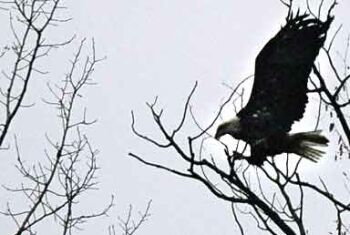
Publisher:
Bonnie King
CONTACT:
Newsroom@Salem-news.com
Advertising:
Adsales@Salem-news.com

~Truth~
~Justice~
~Peace~
TJP
Feb-10-2007 20:28

 TweetFollow @OregonNews
TweetFollow @OregonNews
Oregon Bald Eagle Population Increases as Feds Prepare for Possible Delisting
Salem-News.comThe bald eagle first received national protection in 1967 under the predecessor of the Endangered Species Act.
 Photo courtesy: eaglewatching.com |
(CORVALLIS) - For the fifth year in a row, Oregon's bald eagle populations exceeded recovery goals and studies are showing that the birds have been steadily increasing at an average rate of more than one chick per nesting pair since 2001.
A three percent increase from the state's 2005 population is being reported by Oregon State University researchers, as the U.S. Fish and Wildlife Service closes in on a court-ordered decision on whether to remove the bird from the Federal Endangered Species Act.
The deadline for the agency to make the decision was Feb. 16th, but was just extended to June.
"The goal of listing any animal under the Endangered Species Act is to have the species recover sufficiently to be declassified," said Frank Isaacs, the OSU biologist who has conducted the state's bald eagle survey for the last 29 years.
The bald eagle first received national protection in 1967 under the predecessor of the Endangered Species Act.
The action came after years of population decline due in part to shooting and the widespread use of DDT and other pesticides responsible for the weakening of the bird's eggshells and lowering hatching rates.
In 1973, one year after the banning of DDT, the bald eagle was formally listed as endangered in 43 of the 48 lower states, and threatened in Michigan, Minnesota, Oregon, Washington and Wisconsin. At the time about 400 breeding pairs remained in the lower 48.
"In the late 1970s we started to see the size of the nesting population begin to grow," said Isaacs.
"We first saw increases in areas where they were always common, then nesting sites started showing up in areas where people weren't used to seeing them. Now, there are breeding pairs over much of the state and up through the gorge."
Biologists at the Oregon Cooperative Fish and Wildlife Research Unit in OSU's Department of Fish and Wildlife started tracking and preparing annual census reports of the birds' activities in 1978.
In the 2006 survey a total of 2,098 observations made by more than 340 volunteers and cooperators were used to summarize the state of the birds.
This year's count in Oregon and along the lower Columbia River in Washington found 528 known breeding pairs of bald eagles, an increase of almost 1,000 breeding eagles since the first census.
"This is a species that the public really enjoys seeing and wants to see thrive," said Isaacs. "It proves that if we want to protect and save something we can do it."
As the possibility of delisting bald eagles grows closer, it's time to start considering what it will mean for future eagle populations, said Isaacs.
The birds and their nests will still be protected from hunting and poaching under the Bald and Gold Eagle Protection Act and the Migratory Bird Treaty Act, but their habitat will have much less protection from activity, including development, logging and encroachment.
"There are several questions regarding whether habitat protection will be adequate without the safeguarding of the Endangered Species Act," said Isaacs. "We may lose some nest sites because of minimal protection in the future."
Articles for February 9, 2007 | Articles for February 10, 2007 | Articles for February 11, 2007


Salem-News.com:

googlec507860f6901db00.html

Terms of Service | Privacy Policy
All comments and messages are approved by people and self promotional links or unacceptable comments are denied.
[Return to Top]
©2025 Salem-News.com. All opinions expressed in this article are those of the author and do not necessarily reflect those of Salem-News.com.